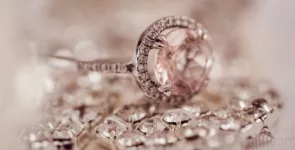The jewelry industry, known for its intricate designs and craftsmanship, is experiencing a technological revolution. Computer-Aided Design (CAD) software is at the forefront of this transformation, allowing designers to create stunning and precise jewelry pieces with ease. CAD software has streamlined the design process, from initial concept to final creation, making it more efficient and accurate.
The Role of CAD in Jewelry Design
Computer-Aided Design (CAD) software has become an essential tool in the jewelry industry. It allows designers to create detailed 3D models of their designs, providing a clear visualization of the final product. This technology not only enhances creativity but also ensures precision, reducing the risk of errors during the manufacturing process.
Incorporating gemstones such as pink diamonds into jewelry designs is made easier and more precise with CAD software. Pink diamonds, known for their exquisite beauty and rarity, require meticulous planning and design to showcase their brilliance. CAD software enables designers to create intricate settings that highlight the unique characteristics of pink diamonds, ensuring that each piece is both beautiful and structurally sound.
Benefits of CAD Software in Jewelry Design
Enhanced Creativity
CAD software opens up a world of possibilities for jewelry designers. It allows them to experiment with complex shapes, intricate patterns, and unique designs that would be difficult to achieve by hand. Designers can easily modify and refine their creations, exploring different styles and concepts without the need for physical prototypes.
Precision and Accuracy
One of the significant advantages of CAD software is its precision. Designers can create detailed and accurate models, ensuring that every element of the design fits together perfectly. This precision is particularly important when working with valuable gemstones like pink diamonds, as it minimizes the risk of damage and ensures a secure setting.
Time Efficiency
The traditional process of creating jewelry designs by hand can be time-consuming and labor-intensive. CAD software streamlines this process, allowing designers to create and modify designs quickly. This efficiency reduces the overall production time, enabling faster delivery of finished pieces to customers.
Cost-Effective
By reducing the need for physical prototypes and minimizing errors, CAD software helps lower the production costs of jewelry. Designers can make adjustments digitally, avoiding the expense and waste associated with reworking physical models. This cost-effectiveness is particularly beneficial when working with expensive materials and gemstones.
The CAD Design Process
Conceptualization
The design process begins with an idea or concept. Designers use CAD software to translate their vision into a digital model. This stage involves sketching the basic shape and structure of the jewelry piece, considering factors such as size, proportions, and overall aesthetics.
Detailed Design
Once the initial concept is in place, designers refine the model, adding intricate details and embellishments. CAD software allows for precise control over every aspect of the design, from the curvature of a band to the placement of gemstones. Designers can view the model from different angles, ensuring that every element aligns perfectly.
Incorporating Gemstones
Incorporating gemstones, such as pink diamonds, requires careful planning and precision. CAD software enables designers to create custom settings that securely hold the gemstones in place. They can experiment with different placements and orientations to maximize the gemstone’s brilliance and enhance the overall design.
Rendering
Rendering is the process of creating realistic images of the 3D model. CAD software can produce high-quality renderings that showcase the jewelry piece in different lighting conditions and environments. These renderings help designers and clients visualize the final product, making it easier to make informed decisions about the design.
Prototyping and Production
Once the design is finalized, the CAD model is used to create a physical prototype. This prototype can be made using 3D printing technology, which produces an accurate representation of the final piece. The prototype is then used to create molds for casting or to guide the manufacturing process.
Final Adjustments
After the prototype is reviewed, any necessary adjustments are made to the CAD model. This iterative process ensures that the final product meets the designer’s vision and the client’s expectations. Once all adjustments are complete, the jewelry piece is produced, polished, and finished to perfection.
Real-Life Applications of CAD in Jewelry Design
Custom Jewelry
CAD software is particularly valuable in creating custom jewelry pieces. Designers can work closely with clients to develop unique designs that reflect their personal style and preferences. The precision and flexibility of CAD software make it possible to incorporate specific requests and make real-time adjustments, resulting in truly one-of-a-kind pieces.
Restoration and Replication
CAD software is also used in the restoration and replication of antique jewelry. Designers can create accurate digital models of damaged or worn pieces, allowing them to restore the jewelry to its original condition. Additionally, CAD software can be used to replicate heirloom pieces, preserving their design for future generations.
Mass Production
For jewelry manufacturers, CAD software streamlines the mass production process. Once a design is finalized, it can be easily reproduced in large quantities with consistent quality. This efficiency is particularly beneficial for producing collections and meeting high demand.
The Future of CAD in Jewelry Design
The future of CAD in jewelry design looks promising, with ongoing advancements in technology and software capabilities. Emerging technologies such as artificial intelligence (AI) and machine learning are expected to further enhance the design process, offering new tools and features that improve creativity and efficiency.
AI-Assisted Design
AI-assisted design tools can analyze design trends and suggest modifications to improve aesthetics and functionality. These tools can also automate repetitive tasks, allowing designers to focus on the creative aspects of their work. As AI technology continues to evolve, it will play an increasingly significant role in jewelry design.
Virtual Reality (VR) and Augmented Reality (AR)
VR and AR technologies have the potential to revolutionize the way jewelry is designed and experienced. Designers can use VR to create immersive 3D environments, allowing them to interact with their designs in a virtual space. AR can enhance the shopping experience by enabling customers to visualize how a piece of jewelry will look when worn, bridging the gap between digital design and physical product.
CAD software has transformed the jewelry design process, making it more efficient, precise, and creative. From conceptualization to final creation, CAD technology enables designers to bring their visions to life with unparalleled accuracy.
Written by Harlow Sweeney








